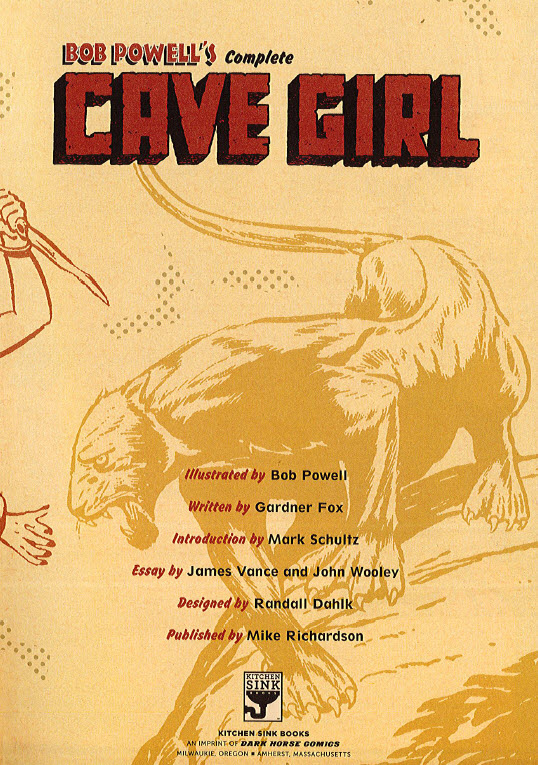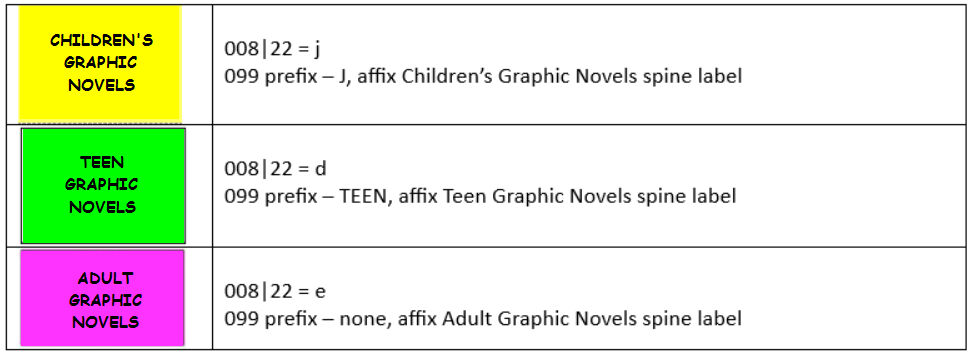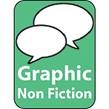Contents
Definition
Fixed field - 008|24
Classification
Adult
Teen
Juvenile
09X Call number
1XX Main entry
245 |n |p Title format for series/part
5XX General notes
590 Intellectual level verification note
6XX Subject headings
7XX Added Entries
Item Entry & Processing
Definition
A Graphic Novel is an original book-length story (fiction or nonfiction) in comic book style, or a collection of stories that have been published previously as individual comic books, typically bound in longer and more durable formats and capturing series of stories with a connected story arc or common theme from one or more titles.
For information on light novels, see Fiction, Light Novels vs Graphic Novels.
Fixed Field - Nature of Contents
- 008|24 = 6 for Graphic novels
Classification of Graphic Novels & Manga
Existing publisher rating schemes will be used as the basis for classification of graphic novels and manga in the appropriate collection based on the intellectual level of the content (i.e., adult, teen or juvenile).
Effective Dec. 20, 2023 books in series with a different audience rating will be classified according to the rating that appears on the book. This may mean some series will have volumes appearing in the teen and adult collections or in the juvenile and teen collections. Cataloguers ensure that the 521 data is accurate. No additional note is required.
Adult classification
Marvel graphic novels rated Parental Advisory (15 and up) and MAX: Explicit Content
DC graphic novels rated T+ - Teen Plus (16 and up) and M - Mature (18 and up)
Kodansha manga rated OT Older Teen (16 and up) and M - Mature (18 and up)
Tokyopop manga rated OT - Older Teen Age 16+ and M - Mature Ages 18+
Viz manga rated T+ - Older Teen and M - Mature
Yen Press rated OT - Older Teen Age 16+ and M - Mature Ages 18+
Image Comics rated T+ Teen Plus - 16 and up and M - Mature Ages 18+
Seven Seas Entertainment - Older Teen - 15+
Teen classification
Marvel graphic novels rated T+ Teens and up (13 and up)
DC graphic novels rated T – Teen (12 and up)
Kodasha manga rated T - Teen (13 and up)
Tokyopop manga rated T – Teen Age 13+
Viz manga rated T for Teen
Yen Press rated T – Teen Age 13+
Image Comics T for Teen - 12 and up
Seven Seas Entertainment - Teen - 13+
Juvenile classification
Marvel graphic novels rated All Ages and A (9 and up)
DC graphic novels rated E – Everyone
Kodansha manga Y -- All ages
Tokyopop manga rated A – All Ages and Y – Youth Age 10+
Viz manga rated A for All Ages
Yen Press rated A for All Ages/Readers
Image Comics E for Everyone - all ages
- For titles from other publishers, used the standard EPL guidelines for classification of print to determine the appropriate graphic novel classification:
Adult: 17+ years
Teen: 13-16 years
Juvenile: 8-12 years
- If the classification has been re-evaluated or requires re-evaluation, add a local note stating the intellectual level has been verified, see 590, 5XX General Notes.
- In rare cases, picture books or easy readers in graphic novel form are added to the collection. These titles are classed as E books and shelved as such. These items are not labelled as graphic novels, but have a 650 Graphic novels subject heading in the bibliographic record.
- Back to Top
09X Call Number
Do NOT follow classification instructions given in DDC (Dewey Decimal classification).
Fictional graphic novels in all languages are classified as fiction according to the intellectual level (adult, juvenile (E and J), or teen, e.g. ABC, E ABC, J ABC, TEEN ABC, French ABC.
Non-fiction works in graphic novel format are classified in the appropriate subject area in Dewey classification, e.g. TEEN 920.72 FRA JAC (the Anne Frank House authorized graphic biography).
For manga and graphic novels associated with a 100 personal name, cutter according to the creator's last name, e.g.,
099 \\ $aADA v.1
100 1\ $aAdachi, Toka.
245 10 $aNoragami stray god.$n1 /$cAdachitoka ; translator, Alethea Nibley & Athena Nibley ; lettering, Lys Blakeslee.For manga and graphic novels associated with a 110 corporate body, cutter according to the title of the series, e.g.,
099 \\ $aTEEN SHU v.1
110 2\ $aPeach-Pit (Group)
245 10 $aShugo chara chan!$n1 /$c[created by Peach-Pit ; manga by Naphtalene Mizushima [and others]; translator, Satsuki Yamashita ; lettering, Vince Sneed].Collections of cartoons, caricatures, comic strips, etc. that are not graphic novels as defined above will continue to be classified in 741.5/741.56.
There are some comic strips which are re-formatted as juvenile novels with text and liberal use of illustrations, e.g. Big Nate strikes again. Class as juvenile fiction.
Other books are collected comic strips and should be classed as such, e.g. Big Nate and friends : J 741.56 PEI. Do not try to force all of the Lincoln Peirce books into fiction or comic strip collections.
Include the volume, number or part information as part of the 09X field for graphic novels which have series numbering and that are catalogued as individual title records. Include the volume, number or part in the 09X even if the numbering is not in the 245 field, e.g.
245 |a Marvel zombies.|n5
099 |a TEEN VAN v.5
245 14 |aThe Goon in Rough stuff
246 18 |aGoon.|n0,|pRough stuff
099 |aPOW v.0
245 00 |aSonic the Hedgehog
490 1 |aSonic legacy series ;|vbk. 1
099 |aJ SON bk. 1
For omnibus versions, include original volume information in the call number, i.e. not the omnibus volume numbering. Do not use omnibus volume information in the call number unless it is the only volume information provided. Omnibus volume information should be added as 246s, e.g.
099 |aJ GOS v.10-12
245 10 |aAsterix.|n[Collecting books 10, 11, & 12] /|cwritten by René Goscinny ; illustrated by Albert Uderzo ; translation, Joe Johnson ; lettering, Bryan Senka.
246 3/ |aAsterix omnibus.|nVolume four
246 3/ |aAsterix omnibus.|nVolume 4
505 0 |abk. 10. Asterix the legionary -- bk. 11. Asterix and the chieftain's shield -- bk. 12. Asterix at the Olympic Games.
740 02 |aAsterix the legionary.
740 02 |aAsterix and the chieftain's shield.
740 02 |aAsterix at the Olympic Games.
NOTE: Existing copies will not be relabelled.
Use the following guidelines to determine the designation that will precede the number. Do not include a space following the abbreviation for the volume/number part:
If the item uses the terms “Volume”, “vol.” or “v.”: label with “v.” plus the number, e.g.
099 |aTAK v.1
If the item uses the term: “number” or “no.”: label with: “no.” plus the number, e.g.
099 |aTAK no.1
If the item uses the term: “part” or “pt.”: label with: “pt.” plus the number, e.g.
099 |aTAK pt.1
If the number appears with only a # (hash mark) preceding it: label with “no.” plus the number, e.g.
099 |aTAK no.1
If the number appears with no designation: label with: “v.” plus the number, e.g.
099 |aTAK v.1
|z subfield
Do not include a subfield code that denotes a volume in the 092 or 099 (i.e. |z)
Do not include a subfield code in the item record call number field (i.e. |z)
Do not place a box around the volume on the IP form, e.g.
099 TEEN SMI v.1
Item Call number field: TEEN SMI v.1
IP Form: TEEN SMI v.1
1XX Main Entry
In cases where the main entry/authorized access point is for a personal name, cutter according to the creator's last name
In cases where the main entry/authorized access point is for a corporate body, cutter according to the title of the series
Bob Powell’s Complete Cave Girl / illustrated by Bob Powell ; written by Gardner Fox ; introduction by etc.
Authorized access point: Powell, Bob, 1916-1967.

Choose the appropriate main entry for each volume and cutter to agree with the main entry, e.g.
Soldier Zero by Paul Cornell (Vol. 1)
100 Cornell, Paul
Cutter: COR
Soldier Zero by Dan Abnett (Vol. 2)
100 Abnett, Dan
Cutter: ABN
Add volume number after cutter in call number even if cutter varies from volume to volume.
245 |n |p Title Format for Series/part
Use individual title records for each part of a series, e.g. 245 |aCase closed.|nVolume1, i.e. do not catalogue as a multi-volume set.
Do not abbreviate words being transcribed in 245, use volume information as given on the chief source of information, e.g. Part 1, Pt. 1, P. 1, etc.
5XX General Notes
Do not use the 500 notes: A graphic novel, A graphic story or Graphic short stories. Instead use LCSH 650: Graphic novels (see below)
Make the appropriate 500 notes for genre and Canadian creator in fictional graphic novels, see Print Materials Fiction Genres
If a phrase “Parental advisory” (or similar) appears on an item, use as a quoted note only if necessary to explain the classification, i.e. why a graphic novel is classified as adult not Teen. Retain a correct 521 audience field note if in a derived record; prefer the use of a 500 quoted note for original records, e.g.
500 |a “Parental advisory”--Jkt.
590 Note for Intellectual Level Verification
Add a note if the classification has been re-evaluated or if the juvenile materials selector has been involved in determining the classification so that cataloguers (and vendors) will not deviate from the audience preference selected, e.g.
590 \\ Intellectual level verified by EPL, Oct 26, 2016
6XX Subject Headings
Ensure that a 65X field for graphic novels is applied to all graphic novels (fiction and nonfiction, adult, teen or juvenile). This can include:
- 650 |aGraphic novels [may be subdivided geographically, e.g. Graphic novels|zCanada but DO NOT subdivide by |vJuvenile fiction or |vJuvenile literature]
- 655 |aGraphic novels|2lcgft
Inclusion of the $zGeographic subdivision is optional (effective Dec. 20, 2023).
Add all other 6XX appropriate subject headings as required.
7XX Added Entries
For all graphic novels, make added entries for all types of illustrator(s), e.g. pencillers, artists, inkers, colorists, etc.; follow EPL policy of tracing three of a type, if more than three, only the first of a list will be given an added entry.
Do not trace illustrator if responsible for cover art only; if in doubt as to the contribution of a listed “illustrator”, record name in 245 but do not make added entry.
Item Entry & Processing
All fiction graphic novels receive a graphic novel label according to the intellectual level: adult, teen, or juvenile. Circle GN on IP form.
EXCEPTIONS: Do not affix a graphic novel label to a juvenile graphic novel that is also determined to be a “Special occasion book” – only one “location” label (matching the item’s home location) can be affixed, see Print Materials Juvenile, Home Locations for juvenile books. Do not affix a graphic novel label to "Toon Books" (Easy Readers in graphic novel format).

For all French fiction graphic novels, affix the French graphic novels label above the spine label. Circle GN on IP form as needed.
These labels will be applied to all French fiction graphic novels with a 650 Graphic novels... or 655 Graphic novels... heading in the bibliographic record, regardless of audience level.
For English nonfiction in graphic novel format, affix a graphic nonfiction label above the spine label. This is not applicable to collections of comic strips, but rather only those works for which a Graphic novel subject heading is used and a DDC classification number assigned (except 741.56... or 741.59...), e.g. The Secret Path (LSC3099981). These works are shelved in the nonfiction collection. (Effective January, 2018)

Do not assign genre or affix genre labels to graphic novels (Effective January 2025).
Affix a “Canadian” label to fiction graphic novels if applicable, circle C on IP form.
Revised: Oct. 6, 2025